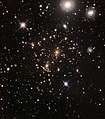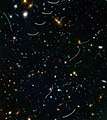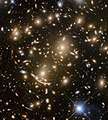Abell 370
Abell 370 is a galaxy cluster located approximately 4 billion light-years away from the Earth (at redshift z = 0.375), in the constellation Cetus.[3] Its core is made up of several hundred galaxies. It was catalogued by George Abell, and is the most distant of the clusters he catalogued.
| Abell 370 | |
|---|---|
.jpg) Abell 370 seen by the Hubble Space Telescope on 16 July 2009. | |
| Observation data (Epoch J2000) | |
| Constellation(s) | Cetus |
| Right ascension | 02h 39m 50.5s[1] |
| Declination | −01° 35′ 08″[1] |
| Richness class | 0[2] |
| Bautz–Morgan classification | II-III[2] |
| Redshift | 0.375[1] |
| Distance (co-moving) | 1.464 Gpc (4.775 Gly) h−1 0.705 [1] |
In the 1980s astronomers of Toulouse Observatory discovered a gravitational lens in space between Earth and Abel 370.[4] A curious arc had been observed earlier near the cluster, but the astronomers were able to recognize it as this phenomenon.[4]
Gravitational lensing
Abell 370 appears to include several arcs of light, including the largest ever discovered with 30" long. These arcs or deformations are mirages caused by gravitational lensing of massive and dark objects located between the observer and the distant galaxies.[3][5] This cluster shows an apparent magnitude of +22.
In 2002, astronomers used this lensing effect to discover a galaxy, HCM-6A, 12.8 billion light years away from Earth. At the time it was the furthest known galaxy.[6]
In 2009, study in the field of Abell 370 revealed a grouping of background galaxies lensed and distorted by the cluster into an arc with the appearance of a dragon, hence nicknamed The Dragon[7] by NASA scientists.[8] Its head is composed of a spiral galaxy,[9] with another image of the spiral composing the tail. Several other images form the body of the dragon, all overlapping.[10] These galaxies all lie approximately 5 billion light years away.
Gallery
 BUFFALO’s survey view on Abell 370.[11]
BUFFALO’s survey view on Abell 370.[11] Abell 370 Parallel Field with Asteroids.[12]
Abell 370 Parallel Field with Asteroids.[12] Abell 370 is one of the very first galaxy clusters in which astronomers observed the phenomenon of gravitational lensing.[13]
Abell 370 is one of the very first galaxy clusters in which astronomers observed the phenomenon of gravitational lensing.[13]
References
- "NED results for object ABELL 0370". NASA/IPAC Extragalactic Database (NED). Retrieved March 15, 2012.
- Abell, George O.; Corwin, Harold G., Jr.; Olowin, Ronald P. (May 1989). "A catalog of rich clusters of galaxies" (PDF). Astrophysical Journal Supplement Series. 70 (May 1989): 1–138. Bibcode:1989ApJS...70....1A. doi:10.1086/191333. ISSN 0067-0049. Retrieved March 12, 2012.
- Starr, Michelle (13 September 2018). "Hubble Just Revealed Thousands of Hidden Galaxies in This Jaw-Dropping Photo - Hello, new desktop wallpaper". ScienceAlert.com. Retrieved 13 September 2018.
- Brunier, Serge (1999-10-28). Majestic Universe: Views from Here to Infinity. Cambridge University Press. ISBN 9780521663076.
- New York Times, "SCIENCE WATCH; Mirages in the Sky May Not Be So Rare" Tuesday, October 18, 1988
- BBC News, "Far away stars light early cosmos" Thursday, 14 March 2002, 11:38 UTC
- Astronomy Now, "Refurbished Hubble gets off to a flying start" 09-09-09 (accessed 2009-11-07)
- New York Times, "The Universe, in High Definition" 09/09/09 (accessed 2009-11-07)
- New Scientist, "Upgraded Hubble telescope spies cosmic 'dragon' " 09.09.09 (accessed 2009-11-07)
- National Geographic, "NEW HUBBLE PICTURES: First Shots From Upgraded Orbiter" Saturday, November 7, 2009 (accessed 2009-11-07)
- "BUFFALO charges towards the earliest galaxies - New Hubble project provides wide-field view of the galaxy cluster Abell 370". www.spacetelescope.org. Retrieved 14 September 2018.
- "Abell 370 Parallel Field with Asteroids". www.spacetelescope.org. Retrieved 6 November 2017.
- "The last of the Frontier Fields — Abell 370". www.spacetelescope.org. Retrieved 6 May 2017.
- Gravitationally lensed images in Abell 370 Authors: Grossman, S. A. & Narayan, R. Bibcode: 1989ApJ...344..637G
- Image of Abell 370 released bu STScI HST in May 2017 : http://hubblesite.org/news_release/news/2017-20
External links
| Wikimedia Commons has media related to Abell 370. |
- Abell 370 on WikiSky: DSS2, SDSS, GALEX, IRAS, Hydrogen α, X-Ray, Astrophoto, Sky Map, Articles and images
- A lot of galaxies need guarding in this NASA Hubble view